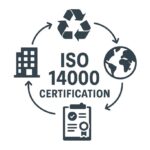Product Carbon Footprint is More than Carbon Dioxide CO2 Emissions
The term “carbon footprint” refers to a measure that considers not only emissions of carbon dioxide but also emissions of other greenhouse gases. The term “carbon footprint” comes from “carbon dioxide and other greenhouse gases.”
The effects of each type of greenhouse gas on the climate are measured in terms of how much CO2 they are “equivalent” to producing. This is due to different greenhouse gases’ varying capacities to contribute to climate change.
- Carbon Dioxide (CO2)
- Methane (CH4)
- Nitrous oxide (N2O)
- Hydrofluorocarbons (HFCs)
- Perfluorocarbons (PFCs)
- Sulphur hexaflouride (SF6)
- Nitrogen trifluoride (NF3)
Why is it important to consider a product's carbon footprint?
The production and use of products contribute significantly to global greenhouse gas emissions. Many products can be made more eco-friendly by lowering their carbon footprint. Product carbon footprint reduction can aid in mitigating climate change and promoting sustainable development.
How can you reduce the carbon footprint of a product?
There are numerous ways to reduce a product’s carbon footprint. Using recycled materials, choosing energy-efficient appliances, and reducing packaging are all simple steps. Choose products with lower emissions footprints, such as those that use renewable energy or are made from recycled materials.
Intentions Regarding the Comprehensive Carbon Footprint of the Product
- Lowering emissions of greenhouse gases and the realization of climate-related objectives
- An investigation into the climate-sensitive points of production within a system of manufacturing
- Encouraging greater openness and honesty throughout the sector
- The establishment of principles and standards compatible with one another on a global scale, which is also coordinated and standardized
Intentions Regarding the Comprehensive Carbon Footprint of the Product
- Lowering emissions of greenhouse gases and the realization of climate-related objectives
- An investigation into the climate-sensitive points of production within a system of manufacturing
- Encouraging greater openness and honesty throughout the sector
- The establishment of principles and standards compatible with one another on a global scale, which is also coordinated and standardized
Product Carbon Footprint – Definition
It has been shown that the approach known as the Product Carbon Footprint (PCF), also often called the Product Carbon Footprint, is the most successful for assessing a product’s influence on the environment. Emissions of greenhouse gases are one manner climate-related consequences present themselves across the whole of the life cycle of a product. These effects manifest themselves from the beginning of the phase devoted to extracting raw materials and carry on through the phases devoted to recycling and disposal. The Product Carbon Footprint is a tool that can assist with the identification, analysis, and, with applying appropriate mitigation strategies, complete avoidance of or a decrease in the severity of these repercussions. It can also help reduce the carbon dioxide emitted by the product.
Besides the carbon footprint associated with the product, there is also something known as the Corporate Carbon Footprint (CCF), which investigates the company’s impacts. Both of these carbon footprints are measured in terms of their environmental impact. The availability of established criteria and standards calculates the PCF and CCF simpler. These criteria and standards are subject to continuous changes to guarantee accuracy.
To achieve the global climate goals set for 2050, which include lowering the quantity of carbon dioxide in the atmosphere, every market good and service must be assessed on how their production and delivery affect the surrounding natural environment. The importance of the PCF will only continue to grow because of this development.
It is essential to distinguish between direct and indirect emissions if one is calculating an individual’s carbon footprint (Scope 1-3). Direct emissions are those that are created by the combustion of fossil fuels. Indirect emissions come from other sources. The emissions generated by other variables are called indirect emissions. In Scope 1, the direct contributions made by the corporation to the total emissions are considered.
Indirect emissions are those created by third-party energy sources, heat, cooling, or steam. This is the focus of the second scope. Scope 3 encompasses any other kinds of indirect emissions that could occur at any point in the upstream supply chain or while the end user is consuming the product. Various activities, such as transportation, manufacturing, or waste disposal, could cause these emissions.
Advantages of the Product Carbon Footprint for your company
- As the first step toward establishing a fact-based management system for sustainability, you will need to analyze the state-of-the-art in your field.
- Find the unrealized potential for cost savings associated with emissions of greenhouse gases, and then work to reduce those costs after you have found that potential.
- Pay attention to the customers as the number of requests for PCFs continues to rise.
Differences between the standards
These approaches have reached a reasonable consensus regarding rules for specific industries or products, recycling, and delayed emissions. However, the standards used to calculate the CO2 footprint are not uniform. There are significant differences between them.
The following are examples:
- For instance, the British PAS does not account for these items: consumer transportation to and from retail locations, employee commuting, capital goods, and human energy input into processes.
- Suppose they contribute less than one percent to the overall impact. In that case, the PAS will let you disregard five percent of the total emissions.
- In terms of greenhouse gas emissions, the Life Cycle Impact Assessment must only consider the six substances specified in the Kyoto Protocol. It is strongly suggested, but not necessary, to include additional product-relevant substances on the list.
Existing standards for calculating a Product Carbon Footprint
The CO2 balance of a product can be evaluated according to several criteria. The following is a list of the most common approaches taken when calculating a carbon footprint:
- Known as the Publicly Available Specification (PAS 2050), PAS 2050 provides an internationally standard approach to determining the CO2 balance of products and services. It was initially developed in 2008 by the British Standards Institute and revised in 2011.
- The standard for Product Life Cycle Accounting and Reporting Developed Under the GHG Protocol
- Standards have been established for measuring product greenhouse gas inventories and public reporting. These standards are based on the initial PAS 2050 approach, published in 2011.
- ISO 14067 is the PCF standard used the most frequently. The standard establishes the balancing boundaries within which climate change alone is deemed an effect category. And the standard is extensively applicable to all goods and encourages transparent communication of the findings.










